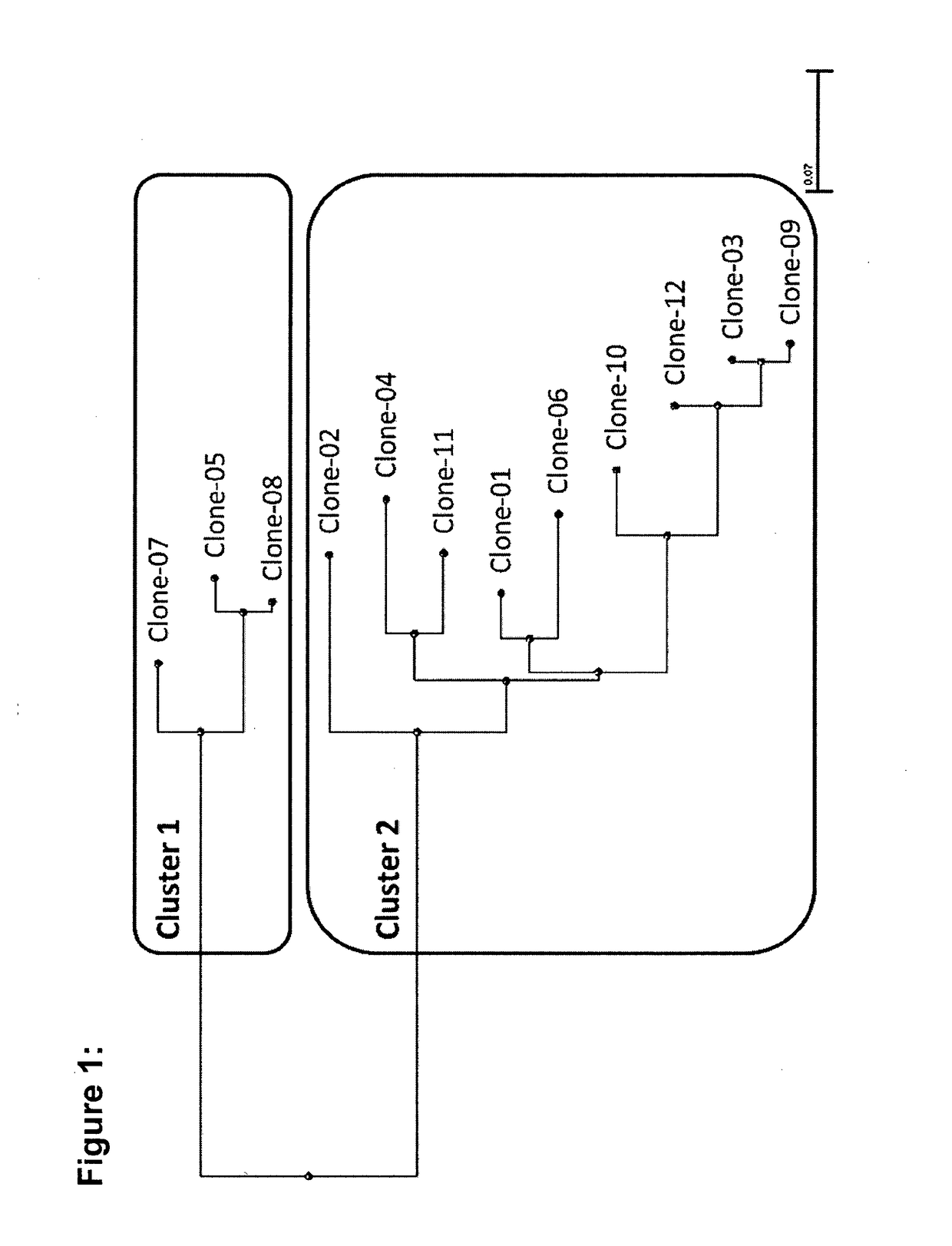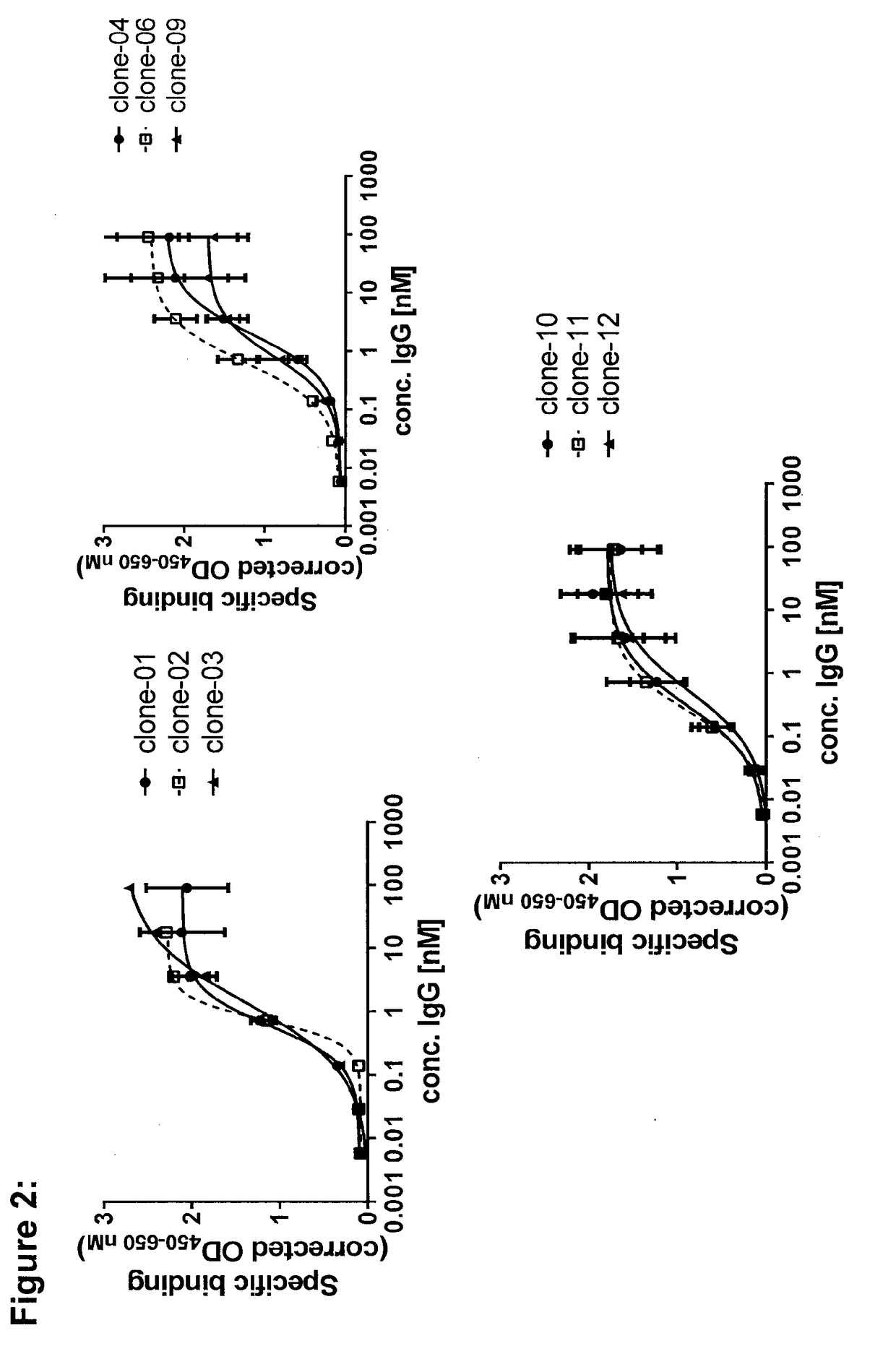Novel multispecific molecules and novel treatment methods based on such multispecific molecules
a multi-specific, novel technology, applied in the field of bispecific molecules, can solve the problems of poor efficiency, decreased the probability of identification and inability to recognize native full-length cd3, etc., to achieve the effect of non-optimal tcr stimulation, and reducing the probability of monoclonal antibodies with t cell-stimulatory activity
- Summary
- Abstract
- Description
- Claims
- Application Information
AI Technical Summary
Benefits of technology
Problems solved by technology
Method used
Image
Examples
example 1
Identification and Selection of Monoclonal Antibodies Binding to a T Cell-Stimulatory Epitope on CD3
[0160]Rabbit memory B cells binding to CD3ε were isolated from one immunized rabbit using fluorescence activated cell sorting. In order to exclude antibodies binding to the interface of CD3ε and CD3γ, a Phycoerythrin (PE)-labeled single-chain protein construct was used consisting of the extracellular domains of CD3ε and CD3γ joined by a flexible peptide linker (scCD3γε). In total, 4,270 memory B cells binding to PE-scCD3γε were individually sorted into 96-well culture plates and cultured at conditions published elsewhere (Lightwood et al, JIM 2006; 316: 133-143). All culture supernatants were first screened by ELISA for binding to scCD3γε, which yielded 441 hits. In a second screening, positive supernatants from the first screening were tested for their ability to bind the native CD3ε embedded in the TCR complex on the surface of Jurkat cells (see Methods below). A total of 22 hits sh...
example 2
Binding of Purified Monoclonal Rabbit Anti-CD3ε Antibodies to Jurkat T Cells and to Cynomolgus Monkey HSC-F T Cells
[0162]Jurkat human T cells and cynomolgus monkey HSC-F T cells were incubated with increasing concentrations of the purified monoclonal rabbit antibodies, as described in the methods section. With all antibodies tested, specific binding to human CD3ε increased with increasing antibody concentrations (FIG. 2). The EC50 values, indicating half-maximal binding to Jurkat human T cells, were very similar for all antibodies, ranging from 0.28 to 1.87 nM (see Table 1, which shows the pharmacodynamic characteristics of purified monoclonal rabbit antibodies. For the qualitative detection of CD69 expression the mean fluorescence intensity (MFI), reflecting the signal intensity at the geometric mean, was measured for both, the negative control as well as for the test antibodies. The normalized MFI was calculated by dividing the MFI of the test antibody through the MFI of the negat...
example 3
Potential of Purified Monoclonal Rabbit Anti-CD3ε Antibodies to Stimulate CD69 Expression on T Cells
[0163]The potential of purified monoclonal rabbit anti-CD3 antibodies to induce T-cell activation as assessed by measurement of CD69 expression (see methods) was compared to the published antibodies OKT-3 and TR66. In the first approach, three different concentrations of cross-linked antibodies were used to stimulate Jurkat cells and CD69 expression was assessed by flow-cytometry 24 h later. A significant increase in CD69 expression was observed with all tested antibodies at 1.25 μg / ml (FIG. 3 and Table 1). Interestingly, all tested rabbit antibodies showed stronger stimulation of CD69 expression than the published OKT-3 and TR66. This is unexpected as the rabbit antibodies bind to human scCD3γε with much higher affinity than OKT-3 or TR66, which, according to prior art, should negatively affect their ability to serially trigger and thereby enhance TCR signaling. With increasing conce...
PUM
 Login to View More
Login to View More Abstract
Description
Claims
Application Information
 Login to View More
Login to View More - R&D
- Intellectual Property
- Life Sciences
- Materials
- Tech Scout
- Unparalleled Data Quality
- Higher Quality Content
- 60% Fewer Hallucinations
Browse by: Latest US Patents, China's latest patents, Technical Efficacy Thesaurus, Application Domain, Technology Topic, Popular Technical Reports.
© 2025 PatSnap. All rights reserved.Legal|Privacy policy|Modern Slavery Act Transparency Statement|Sitemap|About US| Contact US: help@patsnap.com



